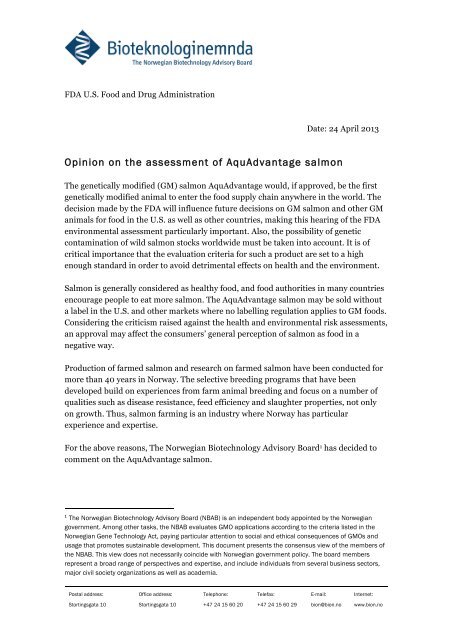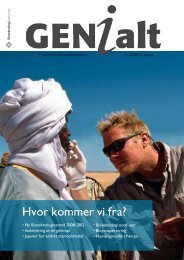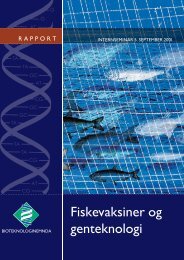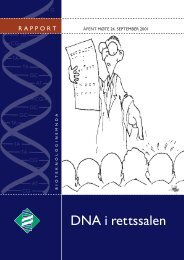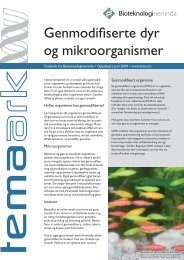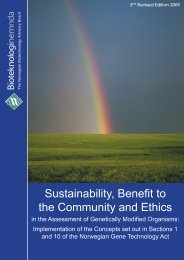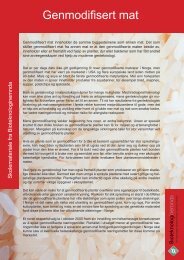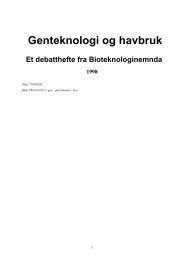Opinion on the assessment of AquAdvantage salmon
Opinion on the assessment of AquAdvantage salmon
Opinion on the assessment of AquAdvantage salmon
Create successful ePaper yourself
Turn your PDF publications into a flip-book with our unique Google optimized e-Paper software.
FDA U.S. Food and Drug Administrati<strong>on</strong><br />
Date: 24 April 2013<br />
<str<strong>on</strong>g>Opini<strong>on</strong></str<strong>on</strong>g> <strong>on</strong> <strong>the</strong> <strong>assessment</strong> <strong>of</strong> <strong>AquAdvantage</strong> salm<strong>on</strong><br />
The genetically modified (GM) salm<strong>on</strong> <strong>AquAdvantage</strong> would, if approved, be <strong>the</strong> first<br />
genetically modified animal to enter <strong>the</strong> food supply chain anywhere in <strong>the</strong> world. The<br />
decisi<strong>on</strong> made by <strong>the</strong> FDA will influence future decisi<strong>on</strong>s <strong>on</strong> GM salm<strong>on</strong> and o<strong>the</strong>r GM<br />
animals for food in <strong>the</strong> U.S. as well as o<strong>the</strong>r countries, making this hearing <strong>of</strong> <strong>the</strong> FDA<br />
envir<strong>on</strong>mental <strong>assessment</strong> particularly important. Also, <strong>the</strong> possibility <strong>of</strong> genetic<br />
c<strong>on</strong>taminati<strong>on</strong> <strong>of</strong> wild salm<strong>on</strong> stocks worldwide must be taken into account. It is <strong>of</strong><br />
critical importance that <strong>the</strong> evaluati<strong>on</strong> criteria for such a product are set to a high<br />
enough standard in order to avoid detrimental effects <strong>on</strong> health and <strong>the</strong> envir<strong>on</strong>ment.<br />
Salm<strong>on</strong> is generally c<strong>on</strong>sidered as healthy food, and food authorities in many countries<br />
encourage people to eat more salm<strong>on</strong>. The <strong>AquAdvantage</strong> salm<strong>on</strong> may be sold without<br />
a label in <strong>the</strong> U.S. and o<strong>the</strong>r markets where no labelling regulati<strong>on</strong> applies to GM foods.<br />
C<strong>on</strong>sidering <strong>the</strong> criticism raised against <strong>the</strong> health and envir<strong>on</strong>mental risk <strong>assessment</strong>s,<br />
an approval may affect <strong>the</strong> c<strong>on</strong>sumers’ general percepti<strong>on</strong> <strong>of</strong> salm<strong>on</strong> as food in a<br />
negative way.<br />
Producti<strong>on</strong> <strong>of</strong> farmed salm<strong>on</strong> and research <strong>on</strong> farmed salm<strong>on</strong> have been c<strong>on</strong>ducted for<br />
more than 40 years in Norway. The selective breeding programs that have been<br />
developed build <strong>on</strong> experiences from farm animal breeding and focus <strong>on</strong> a number <strong>of</strong><br />
qualities such as disease resistance, feed efficiency and slaughter properties, not <strong>on</strong>ly<br />
<strong>on</strong> growth. Thus, salm<strong>on</strong> farming is an industry where Norway has particular<br />
experience and expertise.<br />
For <strong>the</strong> above reas<strong>on</strong>s, The Norwegian Biotechnology Advisory Board 1 has decided to<br />
comment <strong>on</strong> <strong>the</strong> <strong>AquAdvantage</strong> salm<strong>on</strong>.<br />
1 The Norwegian Biotechnology Advisory Board (NBAB) is an independent body appointed by <strong>the</strong> Norwegian<br />
government. Am<strong>on</strong>g o<strong>the</strong>r tasks, <strong>the</strong> NBAB evaluates GMO applicati<strong>on</strong>s according to <strong>the</strong> criteria listed in <strong>the</strong><br />
Norwegian Gene Technology Act, paying particular attenti<strong>on</strong> to social and ethical c<strong>on</strong>sequences <strong>of</strong> GMOs and<br />
usage that promotes sustainable development. This document presents <strong>the</strong> c<strong>on</strong>sensus view <strong>of</strong> <strong>the</strong> members <strong>of</strong><br />
<strong>the</strong> NBAB. This view does not necessarily coincide with Norwegian government policy. The board members<br />
represent a broad range <strong>of</strong> perspectives and expertise, and include individuals from several business sectors,<br />
major civil society organizati<strong>on</strong>s as well as academia.<br />
Postal address: Office address: Teleph<strong>on</strong>e: Telefax: E-mail: Internet:<br />
Stortingsgata 10 Stortingsgata 10 +47 24 15 60 20 +47 24 15 60 29 bi<strong>on</strong>@bi<strong>on</strong>.no www.bi<strong>on</strong>.no<br />
NO-0161 OSLO, NORWAY
Sterility and escape into <strong>the</strong> envir<strong>on</strong>ment<br />
In <strong>the</strong> FDA Draft Envir<strong>on</strong>mental Assessment it is stated that <strong>the</strong> fish will be all female<br />
and triploid, thus effectively sterile, and that <strong>the</strong> possibility <strong>of</strong> <strong>the</strong> fish reproducing in<br />
<strong>the</strong> wild <strong>the</strong>refore is extremely remote. However, <strong>the</strong> data from AquaBounty indicate<br />
that five percent <strong>of</strong> <strong>the</strong> fish will not be sterile. Therefore, some <strong>of</strong> <strong>the</strong> fish may<br />
reproduce in <strong>the</strong> wild.<br />
AquaBounty has applied for c<strong>on</strong>sent to produce <strong>the</strong> salm<strong>on</strong> in inland closed facilities in<br />
order to avoid <strong>the</strong> risk <strong>of</strong> GM salm<strong>on</strong> mixing with wild salm<strong>on</strong>. However, human error<br />
and mechanical failure may occur, and scenarios <strong>of</strong> intenti<strong>on</strong>al and unintenti<strong>on</strong>al<br />
escape should <strong>the</strong>refore be evaluated.<br />
Fur<strong>the</strong>rmore, AquaBounty plans to sell eggs to third parties that may grow <strong>the</strong> fish in<br />
open facilities at sea. Most likely some <strong>of</strong> <strong>the</strong> fish will escape, as a great number <strong>of</strong> fish<br />
escape from salm<strong>on</strong> farms every year. Because salm<strong>on</strong> moves freely through bodies <strong>of</strong><br />
water genetic c<strong>on</strong>taminati<strong>on</strong> or replacement <strong>of</strong> wild fish stocks may occur in <strong>the</strong> U.S. as<br />
well as across <strong>the</strong> Atlantic Ocean.<br />
Envir<strong>on</strong>mental c<strong>on</strong>sequences are not taken into account by <strong>the</strong> FDA because <strong>the</strong><br />
producti<strong>on</strong> is not supposed to take place in <strong>the</strong> U.S. Based <strong>on</strong> <strong>the</strong> above, <strong>the</strong><br />
c<strong>on</strong>sequences in <strong>the</strong> event <strong>of</strong> an escape and <strong>the</strong> impacts <strong>on</strong> wild salm<strong>on</strong> populati<strong>on</strong>s<br />
inside as well as outside <strong>the</strong> U.S. should be assessed in a comprehensive envir<strong>on</strong>mental<br />
risk <strong>assessment</strong>.<br />
Social and ec<strong>on</strong>omic c<strong>on</strong>sequences<br />
In Norway, <strong>the</strong> Gene Technology Act states that a GMO, in order to be approved, must<br />
not be detrimental to health and <strong>the</strong> envir<strong>on</strong>ment. In additi<strong>on</strong>, c<strong>on</strong>siderable weight<br />
should be given to whe<strong>the</strong>r <strong>the</strong> GMO c<strong>on</strong>tributes to sustainable development, is a<br />
benefit to society and ethically acceptable. We note that under <strong>the</strong> US regulatory<br />
regime, social, ec<strong>on</strong>omic and cultural effects <strong>of</strong> <strong>the</strong> proposed acti<strong>on</strong> occurring within<br />
<strong>the</strong> US should also be evaluated, although <strong>the</strong> FDA in <strong>the</strong> summary <strong>of</strong> <strong>the</strong> Draft<br />
Envir<strong>on</strong>mental Assessment states that “courts have held that under NEPA, social and<br />
ec<strong>on</strong>omic effects must be c<strong>on</strong>sidered <strong>on</strong>ly <strong>on</strong>ce it is determined that <strong>the</strong> proposed<br />
agency acti<strong>on</strong> significantly affects <strong>the</strong> physical envir<strong>on</strong>ment.” Because <strong>the</strong> fish is not<br />
completely sterile, 100 per cent c<strong>on</strong>tainment cannot be guaranteed, and <strong>the</strong> salm<strong>on</strong><br />
may be produced in open facilities elsewhere, we believe that <strong>the</strong> possibility <strong>of</strong> <strong>the</strong> fish<br />
affecting <strong>the</strong> physical envir<strong>on</strong>ment in <strong>the</strong> US as well as o<strong>the</strong>r countries cannot be ruled<br />
out. Thus, it appears to us that social, ec<strong>on</strong>omic and cultural impacts should be<br />
evaluated. One relevant issue is: If an escape occurs from a facility abroad, who is liable<br />
for <strong>the</strong> c<strong>on</strong>taminati<strong>on</strong>?<br />
Fur<strong>the</strong>rmore, if <strong>the</strong> general percepti<strong>on</strong> <strong>of</strong> salm<strong>on</strong> is negatively affected, producers <strong>of</strong><br />
n<strong>on</strong>-GM salm<strong>on</strong> and manufacturers <strong>of</strong> n<strong>on</strong>-GM and wild salm<strong>on</strong> in <strong>the</strong> US as well as<br />
o<strong>the</strong>r salm<strong>on</strong> producing countries might suffer ec<strong>on</strong>omic losses.<br />
Page 2
Welfare <strong>of</strong> <strong>the</strong> salm<strong>on</strong><br />
AquaBounty claims that <strong>the</strong>ir GM salm<strong>on</strong> grows faster than n<strong>on</strong>-GM salm<strong>on</strong> in <strong>the</strong><br />
fresh water phase. Data from AquaBounty show increased malformati<strong>on</strong>s <strong>of</strong> b<strong>on</strong>es and<br />
jaws <strong>of</strong> <strong>the</strong> GM salm<strong>on</strong> compared to n<strong>on</strong>-GM salm<strong>on</strong>, most likely due to <strong>the</strong> increase in<br />
growth horm<strong>on</strong>e. Such malformati<strong>on</strong>s are also seen am<strong>on</strong>g o<strong>the</strong>r animals that are given<br />
additi<strong>on</strong>al growth horm<strong>on</strong>es. The FDA does not view <strong>the</strong> malformati<strong>on</strong>s as detrimental<br />
to <strong>the</strong> salm<strong>on</strong> because <strong>the</strong> increase is small. As menti<strong>on</strong>ed by FDA, malformati<strong>on</strong>s have<br />
also been reported in studies <strong>of</strong> traditi<strong>on</strong>al salm<strong>on</strong>. However, <strong>the</strong>se irregularities were<br />
linked to suboptimal culture c<strong>on</strong>diti<strong>on</strong>s and could thus be prevented, whereas altering<br />
culture c<strong>on</strong>diti<strong>on</strong>s could not prevent malformati<strong>on</strong>s due to increased growth horm<strong>on</strong>e.<br />
Quality <strong>of</strong> science<br />
The data used by FDA to evaluate <strong>the</strong> GM salm<strong>on</strong> is provided by AquaBounty and not<br />
by independent scientists. FDA c<strong>on</strong>ducted an open hearing for <strong>the</strong> Veterinary Medicine<br />
Advisory Committee in 2010, where <strong>the</strong> majority <strong>of</strong> <strong>the</strong> scientists c<strong>on</strong>cluded that <strong>the</strong><br />
data were insufficient and that more research was needed before <strong>the</strong> GM salm<strong>on</strong> could<br />
be c<strong>on</strong>sidered for food producti<strong>on</strong>. For comparis<strong>on</strong>s AquaBounty several times used<br />
<strong>on</strong>ly six or seven fish in each group, not evenly distributed according to sex, resulting in<br />
low statistical power and c<strong>on</strong>sequently a poor ability to identify any effects that might<br />
be present. Based <strong>on</strong> such insufficient analyses, <strong>the</strong> FDA draws <strong>the</strong> c<strong>on</strong>clusi<strong>on</strong> that<br />
“because no food or c<strong>on</strong>sumpti<strong>on</strong> hazard has been identified, <strong>the</strong>re are no food<br />
c<strong>on</strong>sumpti<strong>on</strong> risks.” We believe that a robust c<strong>on</strong>clusi<strong>on</strong> regarding such risks would<br />
require new and fur<strong>the</strong>r studies using appropriate sample sizes and study designs, and<br />
that independent scientists evaluate <strong>the</strong> studies.<br />
Impacts <strong>on</strong> human health<br />
In <strong>the</strong> 2010 hearing scientists called attenti<strong>on</strong> to a number <strong>of</strong> disturbing data regarding<br />
possible impacts <strong>on</strong> human health that needed fur<strong>the</strong>r investigati<strong>on</strong>. In additi<strong>on</strong>,<br />
evaluating <strong>the</strong> GM salm<strong>on</strong> as a veterinary drug ra<strong>the</strong>r than food leaves important issues<br />
out <strong>of</strong> <strong>the</strong> risk <strong>assessment</strong>. For instance, feeding studies for assessing health risks have<br />
not been d<strong>on</strong>e. In our view, such fur<strong>the</strong>r studies, including feeding studies, are needed<br />
to draw robust c<strong>on</strong>clusi<strong>on</strong>s regarding possible impacts <strong>on</strong> human health.<br />
Correlated changes when selecting for growth al<strong>on</strong>e<br />
Am<strong>on</strong>g animal breeding pr<strong>of</strong>essi<strong>on</strong>als it is well known that selecting <strong>on</strong>ly for growth<br />
generally affects o<strong>the</strong>r properties negatively. In general, fish that grows faster in <strong>the</strong><br />
first phase <strong>of</strong> <strong>the</strong> growth curve will also be bigger as adults and will reach slaughter<br />
weight earlier. Al<strong>on</strong>g with an increased growth rate, we would expect to see differences<br />
in quality <strong>of</strong> <strong>the</strong> meat such as more coarse structure, less fat and different fatty acid<br />
compositi<strong>on</strong>. The GM-fish that is going to be used for reproducti<strong>on</strong> will be bigger than<br />
<strong>the</strong> normal fish, and this may have negative c<strong>on</strong>sequences that we do not yet know.<br />
Page 3
Also, <strong>the</strong> increased growth rate <strong>of</strong> <strong>the</strong> GM salm<strong>on</strong> claimed by AquaBounty is disputed.<br />
The breeding company Salmobreed asserts that its n<strong>on</strong>-GM salm<strong>on</strong> that is selected for<br />
faster growth in a traditi<strong>on</strong>al breeding program gets as big as <strong>the</strong> GM salm<strong>on</strong>. 2 This<br />
suggests that similar growth can be obtained by traditi<strong>on</strong>al breeding programs.<br />
However, <strong>the</strong>se breeding programs seek to avoid negative c<strong>on</strong>sequences <strong>of</strong> increased<br />
growth by selecting for many parameters, including health and meat quality<br />
parameters. The salm<strong>on</strong> industry does not see growth rate as a major challenge at <strong>the</strong><br />
moment. 2 When evaluating <strong>the</strong> <strong>AquAdvantage</strong> salm<strong>on</strong>, we recommend that its<br />
properties, including growth performance, be compared with <strong>the</strong> results obtained by<br />
<strong>the</strong> best traditi<strong>on</strong>al breeding programs.<br />
The Internati<strong>on</strong>al Salm<strong>on</strong> Farmers Associati<strong>on</strong> (ISFA) has declared that “[i]n<br />
accordance with sound envir<strong>on</strong>mental practice, <strong>the</strong> ISFA firmly rejects transgenic<br />
salm<strong>on</strong> producti<strong>on</strong>”. 3 In line with ISFA's policy Norwegian fish farmers have stated that<br />
<strong>the</strong>y do not want to produce GM salm<strong>on</strong>. 4<br />
C<strong>on</strong>clusi<strong>on</strong><br />
C<strong>on</strong>sidering <strong>the</strong> criticisms that have been raised against <strong>the</strong> health and envir<strong>on</strong>mental<br />
risk <strong>assessment</strong>s, in our opini<strong>on</strong> approval for <strong>the</strong> <strong>AquAdvantage</strong> salm<strong>on</strong> should not be<br />
granted.<br />
Sincerely yours,<br />
Lars Ødegård<br />
Chairman<br />
Sissel Rogne<br />
Director General<br />
2 www.salmobreed.no/newsletters/en/newsletter_5_2011.pdf<br />
3 IFSA statement from <strong>the</strong> 17 th General Meeting in 1996, rec<strong>on</strong>firmed in 1999. ISFA is an internati<strong>on</strong>al<br />
associati<strong>on</strong> with <strong>the</strong> following members: Australia, Canada, Chile, Faroe, Iceland, Ireland, New Zealand, Norway,<br />
UK and USA.<br />
4 Letter from The Norwegian Seafood Federati<strong>on</strong> 31 August 2004.<br />
Page 4


